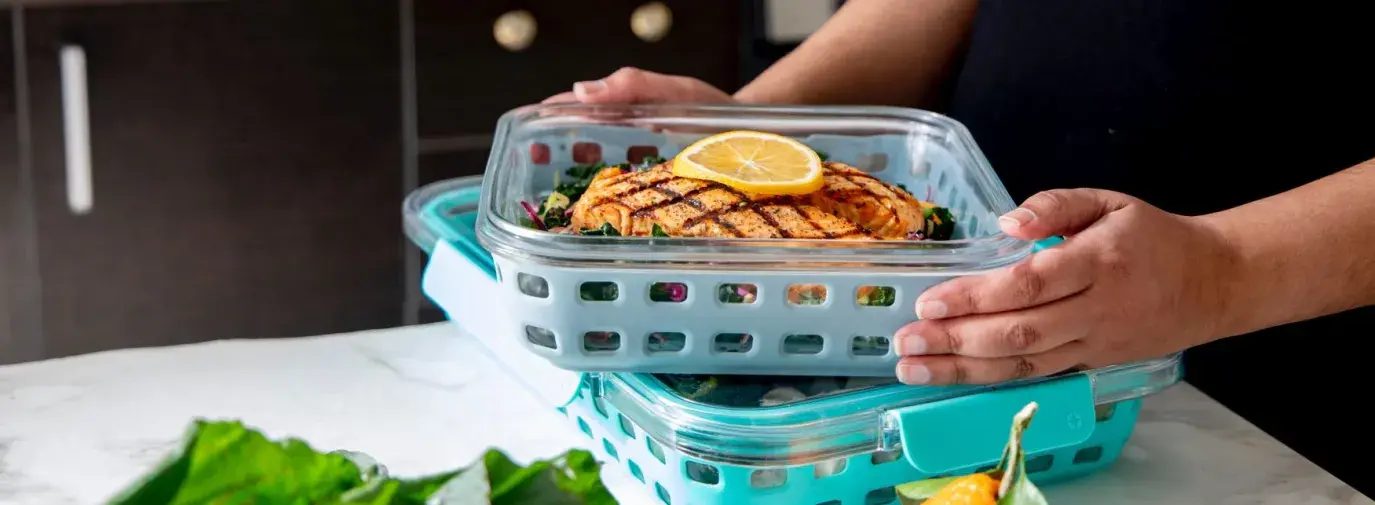
When it comes to eating green, making sure your leftovers don’t go to waste is important. But not all storage containers for those leftovers are created equal. Avoid harmful chemicals entering your food by choosing safer storage and cooking options.
Avoid plastic containers (plastic numbers 1-7)
You might have heard of BPA (p. 14), a chemical used in plastic until around 2013 when increasing regulations reduced its use in products that touched food. Manufacturers replaced BPA with BPS or BPF, which are similar in structure and effects in animal studies but are not yet regulated, so companies that use them to make containers can claim their products are BPA-free. Food-grade plastics have recycling numbers 1-7 on the package, but that doesn’t mean they’re truly safe for food.
However, if you spend time on restaurant supply store websites, you will find lots of claims that say “safe to microwave,” particularly as regards #5 plastic, polypropylene, which is often used in takeout containers and is easily poised for reuse.
Endocrinologist Dr. Frederick Vom Saal of University of Missouri explains that plastics like BPA are harmful to human health, though not technically “toxic,” because toxicology studies what quantity a material could kill a person. Hormone-disrupting chemicals like BPA are harmful at trace amounts, far before the level at which they could kill you, Dr. Vom Saal explained.
Although it’s environmentally friendly to reuse takeout containers, avoid heating food in those containers or putting hot food in them, as plastics shed chemicals faster when exposed to heat and moisture. It’s better to reuse them to store dry foods. If you choose to use them to store cold leftovers that have cooled on the counter before putting them in plastic in the fridge, be sure to transfer the contents to a glass or ceramic bowl before heating.
Choose this: Stainless steel or glass storage containers are both safe for hot foods; glass is safe for microwaving food. You can get a set of glass containers for $30, or use jars from items like pasta sauce.
Avoid plastic films (numbers 3 or 4)
Unfortunately, these plastic films pose the same risks as other plastics when heating food, as far as chemicals interacting with heat and moisture. Furthermore, plastic films for wrapping cold foods are not sustainable because they are a petroleum product, cannot be recycled, and don’t break down in the landfill. They are designed to be used once and tossed.
Choose this for heating: When heating food in the microwave, place a bowl or glass casserole topper over your plate to prevent splatter.
Choose this for wrapping: For a more sustainable and healthy option for wrapping cold foods like a cut apple or a sandwich, use wax wraps. Wax wraps come in various sizes and are made of cotton cloth and nontoxic beeswax (or vegan wax like soy) and can be molded with the heat of your hand to fit around foods or plates going into the fridge. They can’t be heated in a microwave, but they can be washed and reused for years then composted for disposal. Get one wrap from Beeswrap{GBN} for $7, or a set for around $18.
Avoid aluminum foil
Made with bauxite, which is extracted through damaging open-pit mining, aluminum is infinitely recyclable. Yet as of 2018, only about 35% is actually recycled, according to the EPA—though aluminum cans are recycled at about 50%, making them the most successful recycling item. It is far less energy-intensive and damaging to recycle aluminum than to make it new from raw materials. A 2019 study published in Food Science & Nutrition found that using aluminum foil when baking contaminates food, particularly meat and fish, with some level of aluminum. Even though the aluminum amounts found in baked foods were not alarming, the researchers noted that aluminum can present a risk for children and certain susceptible adults. Another study from 2020 in the International Journal of Environmental Research and Public Health came to the same conclusions.
Choose this: In 2018, Safer Chemicals, Healthy Families and Toxic-Free Future investigated the toxic chemical PFAS in food packaging from paper-based takeout containers and found it absent in baking and cooking supplies like paper baking cups and parchment paper sold in the grocery section. Parchment paper comes in both sheets and rolls and can be used in baking, grilling, frying, and steaming.
Silicone baking tray liners or mats are often used for lining baking pans, and are considered inert (non-leaching) as long as the silicone is marked food grade, baked at the temperatures recommended, and not scratched or heavily worn. Silicone is not made from plastic, so if it smells plasticky out of the package that is a sign it might not be 100% silicone. Since there is no at-home test for pure silicone, the safest bet is to skip the silicone and use a longer-lasting nontoxic option.







